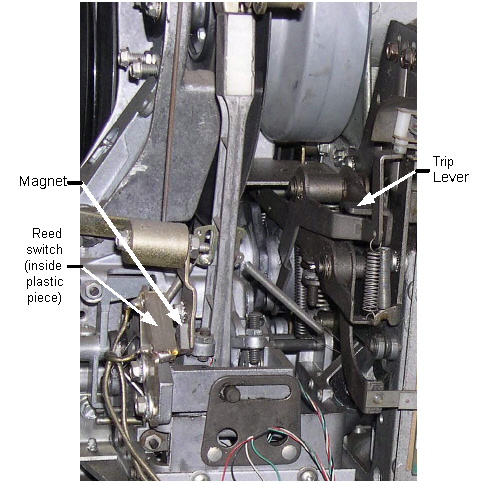Symptom 4:
Cannot reject record, either automatically when it finishes, from the switch on the back of the cabinet, or from the optional (P)RVC.
This symptom could be caused by a couple of problems, so the first thing to do is to eliminate one.

Assuming your machine is a 100-selection S100 or newer, or a 160-selection SS160 or newer, skip to the next paragraph. If it is older, try the rear cabinet or Remote Volume Control (RVC) reject button. If this works, the problem is caused by a dirty or misadjusted mechanism reject switch. This is a microswitch, mounted just to the left of the pickup arm. See part (b) of the photo at left. Many times these switches go bad, so the easiest thing to do is to check it with an Ohmmeter. Place the machine into play, and turn off the power. As you manually move the pickup arm in toward the turntable, you should hear a click when the switch closes. At the same time, you should get continuity between the Common and NO (Normally Open) terminals of the microswitch. If not, the switch is defective. Sometimes, a defective switch can be taken apart and fixed. Otherwise, it must be replaced. In either event, the trip switch adjustment must be performed as specified in the Service Manual for the machine. If you don't have a Service Manual, they are available from Always Jukin', Victory Glass, or Stamann Musicboxen for those in Europe. If the rear cabinet switch or RVC reject does not work, the problem is most likely with a dirty or misadjusted mechanism V switch contact.
For the newer machines, the first thing to do is to try the reject button on the back of the machine or on your PRVC, if you have one. If this works, the problem is probably on the mechanism. Otherwise, the problem is probably in the amplifier.  Problem in the mechanism:
Problem in the mechanism:
 Problem in the mechanism:
Problem in the mechanism: A new-style trip switch was introduced on the mechanism for these newer machines. A magnet and reed switch replaced the older micro-switch. The magnet and reed switch can be seen in the photo at left. When the needle reaches the lead-out groove of the record, the magnet causes the reed switch to close, which in turn energizes the Mute/Trip relay in the amplifier. The magnet was fastened to the pickup arm assembly using an epoxy glue. After many years of alternating cold/hot cycles (especially if the machine sat in a garage or barn for years), the magnet has a tendency to fall off, and lodge itself either in the guts of the pickup arm frame or in the base casting, or under the mechanism. If the magnet falls into the guts of the mech, it could damage something when the carriage moves or when the pickup arm shifts from one side of the record to the other. The solution is to locate the magnet or get a new one, and epoxy it back where it belongs.
Problem in the amplifier:
The LPC1 jukebox introduced a Mute/Trip relay in the amplifier. The trip switch in the mechanism (for the machines prior to the S100/SS160, this was a micro-switch) is used to energize this relay. When this occurs, both channels of the amplifier are muted, and an additional set of relay contacts close to energize the Trip Solenoid on the mechanism. The relay is also energized by the reject switch on the back of the machine, or the reject button on the PRVC. If this relay does not energize, or if the contacts are misadjusted or dirty, the mechanism will not trip. For the TSA-series amplifiers, this relay is in a small metal can, inside the chassis next to the output transformers. For the later SHP amplifiers, it is a plastic-enclosed plug-in relay between the heat sink and the power transformer. If the relay does not energize, it could be due to a bad relay, or an open connection somewhere between the switches and the relay. The relay contacts are in series with a mechanism switch, contact V for the LS1/early LPC480, or 3M12 for the later machines. A dirty or misadjusted contact here could also cause this problem.